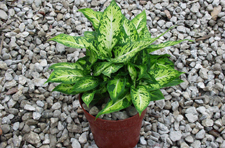'Sparkles' DieffenbachiaReturn to: MREC Home Page R.J. Henny, Associate Professor and
Geneticist Introduction Dieffenbachia are important ornamental tropical foliage plants because of their attractive foliar variegation, ease of production, and adaptability to interior environments. Twenty two cultivars were listed in the 1991-92 Florida Foliage Plant Locator (Reisch, 1991). Most cultivars have originated from private collectors or as mutations of established cultivars. Because Dieffenbachia occur in a diversity of sizes, growth habits, and variegation patterns, they were included in the foliage breeding program at the Central Florida Research and Education Center, Apopka. The hybrid Dieffenbachia x 'Sparkles' is the fifth hybrid to be released from that program (Henny et al., 1987a, 1987b, 1988, 1989). A mature plant of Dieffenbachia
'Sparkles' Origin and description 'Sparkles' Dieffenbachia is the result of several generations involving 20 parents. All parent plants were numbered accessions maintained by the Author. Since the accession numbers have been used only in this breeding program and mean little to others, the extensive pedigree of 'Sparkles ' has not been included in this paper, but is available on request from the author. The dominant features of 'Sparkles' include its bright foliar variegation pattern, which is highlighted by white midribs and petioles; its compact growth habit; and production of numerous basal shoots (Fig. 1). Performance Growth characteristics of 'Sparkles' were determined during a greenhouse trial initiated in Feb. 1993. This test used uniform liners obtained from a commercial tissue-culture laboratory. Thirty 10-week-old liners were potted into 1.6-liter (15-cm) pots filled with Vergro Container Mix A [a mixture of 2 Canadian peatmoss: 1 vermiculite: 1 perlite (by volume)] . Plants were fertilized with Osmocote (19N-6P-12K) at rates of 2.5, 4.2, or 5.9 g/pot per 3 months. There were 10 replications per fertilizer level. Plants were grown for 24 weeks, at which time their size and quality were measured. Data included plant height (with leaves held upward), length and width of the third newest leaf, number of basal shoots, and a visual rating of plant quality. At this time, plants were removed from the greenhouse and placed in an interior room where they received 17 µmol-m-2·.s-1 Iight from fluorescent bulbs 12h daily. After 3 months, plants were evaluated for holding quality. All plants in this growth test performed well and received an "excellent" rating for appearance. The lack of significant statistical differences in growth (plant height, ~33 cm; leaf length, ~20 cm; leaf width, ~9.5 cm) between fertilizer levels indicates that 'Sparkles' tolerates a range of fertilization. 'Sparkles' averaged ~17 basal shoots per plant, which is a high and desirable number, since it results in full and compact plants. After 3 months in an interior room, all plants had maintained their good color definition and compactness and graded out as excellent quality. 'Sparkles' Dieffenbachia is intended for commercial foliage producers growing finished Dieffenbachia in 1.6-liter (15-cm) pots. Its freely branching and compact growth habit also may make it suitable for production in 0.5-liter (10-cm) pots. This cultivar performs exceptionally well in interior environments. Availabiliy 'Sparkles' Dieffenbachia is being propagated by Florida tissue-culture laboratories that assisted in its selection, initial increase, and several grower evaluations. Names of cooperating laboratories may be obtained from the Florida Foundation Seed Producers, P.O. Box 309, Greenwood, FL 32443. Literature Cited
[Revised - 2/28/97] |
